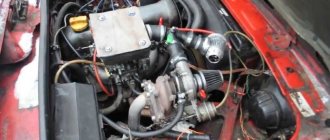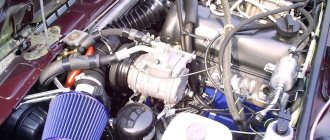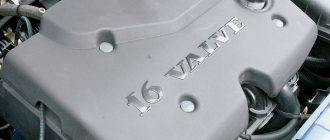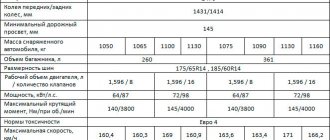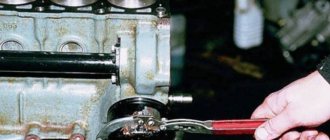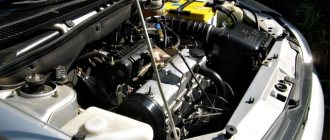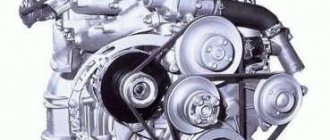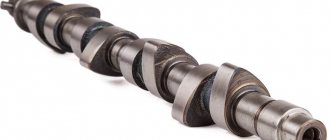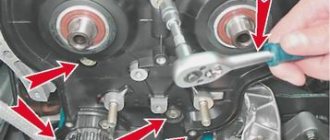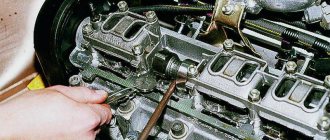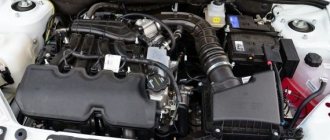Installing a turbine is the most common way to improve the power characteristics of VAZ cars. Atmospheric modification of the engine with a cylinder head bore, a sports exhaust system and sports shafts will be more affordable, but it is limited to a limit of 120-130 hp. Proper turbocharging allows you to remove more than 200 horses from a car. When choosing between turbocharged and naturally aspirated engines, proceed from the tasks assigned to the car. Refinement of the naturally aspirated engine allows you not to get lost in city traffic among more powerful foreign cars. Turbo is better for racing.
In addition, it is almost impossible to legalize a turbo engine in a VAZ in Russia.
Installing a turbo on a VAZ 2114: where to start
Installing a turbine on any car begins with a thorough examination of the hardware. You can’t just go to the store and buy a ready-made kit. And even if it is possible, the system will still have to be modified.
Turbocharged engine VAZ 2114
If you take on this task, consider the following:
- A number of stock units of the VAZ 2114 are unsuitable for a car with a power of over 150 hp. It will not be possible to do without re-equipping the suspension and brakes, installing wider wheels with a turbo engine.
- Tuning foreign cars is partly easier if the model being tuned has “bigger” brothers with turbo engines. Tuning usually comes down to searching, purchasing and adjusting ready-made factory units. It’s more difficult with Togliatti-made cars - VAZs don’t install turbines. Fortunately, in large cities there are tuning studios that develop and produce tuning parts. True, their products are mostly unlicensed, so there will be problems with legalizing changes.
- The correct choice of turbine is the key to successful turbo tuning. Before realizing your dream, we recommend that you read brief descriptions of the turbines used to modify the VAZ.
Installing boost on the engine
Installation of the turbine should be carried out only by those motorists who have sufficient experience and knowledge in the technical features of the operation of the entire system. Direct installation instructions are as follows:
After purchasing a supercharger, you need to unpack it and conduct a visual inspection - the body must be intact and have no deformed areas. It is also necessary to check the technical condition of the oil supply hole. Check carefully - there should not be even the smallest parts inside the boost. Before directly installing the turbine, it is necessary to fill it with oil. The type and characteristics of the oil play an important role in determining the performance of the device and the reliability of the entire system. The turbine should be positioned so that the oil supply hole is at the top. Oil is poured into the hole, which should fill the turbine to the brim. Using a hand pump, you need to create pressure that pushes the oil into the interior and lubricates all the internal parts. During pumping, a hissing sound may be heard - this is normal. The procedure is performed several times, after which all the oil is poured through the drain hole. The oil supply hole is located strictly vertically and is connected to the installed compressor on the engine
It is necessary to pay attention to the inclination of the feed hole angle. The permissible deviation from the norm should be within 10-15 degrees
The car owner must make sure that the oil drains freely, without additional force. For ease of installation of the turbine, it is recommended to remove the heat shield, generator and exhaust manifold. After this, all antifreeze is drained. A hole is carefully drilled into the engine, into which a fitting with a thin layer of sealant is then installed. A heat shield, the turbine itself and the intake manifold are installed. The next step is to attach the treatment hose to the fitting and turbine, and then install the external wastegate. A silicone hose is attached to the fitting, which is cut in half and connected to the T-fitting. After this, all that remains is to install the intake piping and intercooler.
And a visual video with the installation of a turbine on a VAZ 2109 engine:
After installing the turbocharger, it is necessary to conduct an initial test of the functionality of the entire system. To do this, you need to start the engine from the starter. In order for the starter to be able to crank the engine, but not start it, the car owner must remove the voltage wires. In this case, the oil pressure sensor will go out, and the pressure on the oil supply line will drop significantly. If the entire system is working normally, you need to start the engine and leave it running for 10-15 minutes at idle speed.
The first thousand to one and a half kilometers must be carried out in run-in mode. In this case, the running-in mode should be such that the turbocharging does not develop a pressure of no more than 0.5 bar. Drivers who do not have a cabin pressure sensor installed in their vehicle should not exceed 50% of the rev limit. Also, car enthusiasts should remember that the turbo must cool before stopping the engine completely.
The diagram below allows you to see what place it occupies in the system.
Turbines for VAZ cars
There are many options for installing a turbine on the 2114 model. Theoretically, anything can be adapted, but the following models are best suited for an 8-valve engine:
- Garret 1752;
- Mitsubishi TD04 (installed on Mitsubishi Lancer EVO, Subaru Impreza WRX, and some other models);
- IHI VF10 (this model was equipped with the 1st generation Subaru Legacy cars), as a variant of the VF11-20 (stock for the 2nd generation Legacy);
The list can be expanded with dozens of positions, including more powerful turbines TD05, TD06, VF23-30.
For the first boost we recommend Garret, TD04 or IHI VF10-20. They are widespread, inexpensive and repairable.
Moreover, if there is not enough money for new equipment, it is not difficult to find used kits in decent condition due to the transition of their owners to more powerful equipment
Turbo VAZ
How to assemble the optimal turbo engine for the city.
Recently, many owners of VAZ cars have been interested in how to assemble the optimal turbo engine for the city. In this regard, we decided to provide you with specific recommendations on how to assemble it most competently and without extra costs.
The basis of our future turbo engine will be the currently very popular VAZ sixteen-valve engine with the index 21126 from the Lada Priora car. But our guide can be considered universal, because following it, you can assemble a turbo engine on any other base. The key point is not so much the specifics of individual engines, but rather the approach and scope of their future transformations.
And so, the first thing you need to do is disassemble the engine and assess its condition. If the engine has “good mileage”, then the cylinder block is given for boring to the next repair size. When assembling the block, so-called turbo pistons are used. The most common and well-proven option is turbo pistons, modified from pistons. They are distinguished by an enlarged (up to 20 cc) combustion chamber and counterbores for a sixteen-valve cylinder head. Standard Priorov connecting rods are also not suitable for a turbocharged engine. The best replacement for them would be the standard VAZ 2110 connecting rods. But the crankshaft remains “original” - 75.6 mm. As a result, we get an engine with the same volume (1.6L), but with a compression ratio reduced to 7.6:1. Similar “bottom” configurations are actively used in the construction of turbo engines with power up to 400 hp.
At the next stage, you need to decide on the turbine itself. In our opinion, the most suitable for everyday use is the TD04L turbocharger (standard for the Subaru Impreza WRX); it is characterized by early pickup and a fairly wide operating range - an excellent choice for driving in the city. The maximum power is about 250 hp, which will also allow it to demonstrate decent results in amateur Drag-racing competitions. If you want more power, then choose a TD05 or GT28 turbocharger. The selected turbine will require an appropriate turbo manifold. You also need to supply oil to the turbine and implement oil drainage, organize the supply and drainage of coolant. It is very important to use reinforced oil supply and silicone reinforced antifreeze lines. It is the reinforcement of these nodes that will allow you to forever forget about possible problems with them.
When choosing an intercooler, remember that airflow with a standard bumper is very poor. When installing a large intercooler, the radiator airflow will be completely ineffective, which means you are guaranteed constant overheating. For use in the city, you can limit yourself to a 450x180x65 intercooler. It fits under a standard bumper, completely satisfying your cooling needs. In addition, it is better not to create an air line with a large diameter in a city car. You shouldn’t complicate the installation process and end up with turbo lag - this is a slow response of a turbocharged engine to pressing the gas pedal due to the need to increase the pressure in the air line itself. Based on this, the smaller its volume, the less turbo lag there will be. Use an aluminum piping kit with a diameter of 51 mm - this is the best choice for installing the air line. If you are building a motor with a power of about 300 hp. and plan to participate in competitions quite often, choose a 550x230x65 intercooler and piping with a diameter of 57 mm.
The standard receiver will need to be replaced with a special turbo receiver, which differs from the atmospheric versions in its small volume and modified geometry. It is advisable to replace the standard throttle pipe. The most suitable pipe is with a valve diameter of 54 mm. An excess pressure relief valve, in other words a blow-off, is installed on the air line in front of the damper. It is this part that produces a spectacular “zilch” when changing gears, i.e. when releasing the gas pedal.
Be sure to select the correct fuel injectors. This must be done based on the engine power, because it is important to provide the increased amount of air with the required amount of fuel supply. Planned engine power 200 hp. – stop at ACCEL 378 cc injectors. For the needs of a 250 hp engine. you should use injectors with a capacity of 432 cm3/min from FORD RACING or ACCEL 462 cm3/min. But for an engine more than 300 hp. Nozzles with a capacity of more than 600 cc/min are recommended, for example, SIEMENS Deka 630 cc/min or their analogues.
Along with the injectors, we also change the fuel pump, which also has greater performance. For example, the Walbro fuel pump is characterized by the fact that it can withstand the loads of the most powerful engines that can be found in most racing cars.
In addition to the fuel supply, modify the engine management system itself. In particular, it is better not to use a traditional mass air flow sensor (MAF); it is usually replaced by an absolute pressure sensor (MAP) and an air temperature sensor (ATS). This way, you will ensure reliability and the ability to work with all the cutting-edge programs that control the operation of the motor.
When selecting an absolute pressure sensor, choose the model whose upper range is closest to the performance characteristics. In other words, if you plan to use approximately one bar of pressure in the turbo engine, then it is not advisable to use a DBP with an upper value of 3 bar, otherwise you will not be able to fine-tune the turbo engine. When solving the problem of choosing the best options for sensors and injectors, it would be most rational to take the advice of a specialist who will be involved in tuning the assembled turbo engine.
Another important point is the selection of camshafts. The whole difficulty is that their choice is individual for a separate turbo engine. So, for a simple project, standard camshafts will suffice. But they will have to be replaced if an increase in power in the uppermost range is planned. Our advice is to install camshafts designed specifically for turbo engines. Such turbo camshafts allow the engine to perform excellently, both in the urban cycle and in competition conditions.
Assembling a turbo engine also affects cylinder head issues. So, for city driving you can limit yourself to a standard cylinder head. But if you plan to get the most out of the engine, and the car is being prepared for drag racing, then installing a cylinder head with enlarged ports and valves is advisable. This will allow you to get more power and move the torque plateau to higher speeds.
The output of a turbo engine will be maximum as the diameter of the exhaust pipe increases, starting from the downpipe itself and to the end can. Remember that by narrowing the line in at least one place, you will reduce its entire diameter. For engines with power from 200 hp. It is considered optimal to use an exhaust system with a pipe diameter of 60 mm. As a ready-made solution, you can safely use a resonator, bend and universal muffler made of stainless steel from the Russian manufacturer MG-RACE. These elements of the exhaust system have proven themselves and are often used in practice.
The clutch for a turbo engine, in particular a city engine, is a particularly important point. We recommend using the PILENGA Sport kit with a metal-ceramic driven disc with a damper. Of course, using such a clutch in city traffic jams causes some inconvenience, but it does an excellent job of transmitting the torque of an engine with a power of up to 300 hp.
From all of the above, we can draw an important conclusion that converting a standard engine into a turbo engine is much easier, cheaper and more profitable than working with a model that has undergone full atmospheric tuning, because Almost all engine elements are replaced. Carefully select components, pay attention to every detail when assembling, do not skimp on qualified tuning of the assembled turbo engine - this is what guarantees a long service life and power characteristics of your engine.
For your convenience, we have added full-fledged turbo kits to the catalog, which include all the necessary parts for assembling a turbo engine. By purchasing such a kit, you significantly save your time and money.
Turbo kit Garret 1752
Turbo kit Garret 1752
Turbines from Garrett are consistently among the most popular among VAZ owners.
Among the reasons for this:
- sold as a ready-made set, there is no need to assemble individual elements using spare parts at car dismantling yards;
- relatively low cost (a new set will cost 30-35 thousand, used ones can be found in the range from 15 to 25 thousand);
- without any special modifications, you can remove the boost from the car to 0.5 bar, increasing power to 120-130 hp. and torque up to 180-200 Nm;
- with additional modifications to the boost system, the boost can be increased to 1 bar, power – up to 170-200 hp, and torque – up to 240 Nm.
The boost kit from Garret is optimal for novice fans of turbo tuning. By setting the boost to 0.5 bar, you can get a good increase in power without reducing engine life. For serious “rides,” this option is not suitable due to its limitations.
A little theory
Toyota Sera 1.5 turbo 4WD Serafima Logbook MythBusters FHE connecting rods
Such improvements can be carried out more effectively by those who have a clear understanding of their own actions. To do this you need to understand the theoretical part.
So, the car’s power and fuel consumption depend on the properties and degree of enrichment of the fuel-air mixture entering the cylinders, as well as on its volume.
The fact is that an ordinary engine, when operating, pumps air into itself due to the vacuum created by the piston. In a turbocharged power unit, this work is done by a turbocharger. At the same time, the air is compressed earlier, which allows you to pump in a larger volume. In other words, you can burn a larger volume of fuel. The result is an increase in engine power in relation to engine volume and fuel consumed.
One fundamental point: air, as is clear, heats up under strong compression. Secondly, it will heat up during compression in the combustion chamber. With all this, detonation may occur. And, in addition, due to heating, the air density in the cylinder will decrease, which will naturally reduce the efficiency of the entire system. To remove these bad phenomena, intercoolers are used - air coolers from the turbine. They are a radiator.
As already mentioned, there are two types of compressors:
- A turbocharger that operates by using the energy of exhaust gases. The processed gases enter the impeller and spin it, which is why air is pumped;
- Mechanically driven compressor. It is powered by a motor drive. With all this, efficiency decreases and fuel consumption increases compared to the first version of the compressor, because the mechanical supercharger takes away part of the power from the internal combustion engine.
The entire system, not counting the turbine itself, contains several more fundamental components that need to be kept in mind during installation:
- a control valve that maintains this pressure;
- a bypass valve, which ensures that compressed air returns back to the compressor inlet pipes if the engine throttle valve is closed;
- a bleed valve that releases compressed air into the atmosphere when the throttle valve is closed;
- air pipes;
- oil pipes (serve for lubrication and cooling of the turbine).
Hi all ! In this video I will talk about the design of a turbo engine in our implementation. Enjoy watching.
Refinement and modernization of the carburetor. The main shortcomings of the carburetor injection system and methods for eliminating them, settings. Intake manifold tuning.
Turbines based on the TD04 turbo compressor
Turbine TD04L with actuator
The Mitsubishi TD04 compressor and its various invariants (TD04H, TD04L, TD04HL and others) are one of the most common Japanese turbo systems in Russia. Installed on Mitsubishi Lancer Evolution IV-V generations, turbodiesel Mitsubishi Pajero, as well as many Subaru models of the mid-1990s.
The advantage of this compressor is that in the factory version it made it possible to extract a solid 280 - 340 Nm and 280 hp from 1.6 - 2.0 liter engines. In addition, it is compactly placed under the VAZ hood.
High-performance turbos like the Garret GTX30 (installed on the Toyota Chaser or Mark II and German BMW e39 cars) are more difficult to place under the hood. There are precedents, but doing it on your own is not easy.
The build quality of the Japanese turbine is higher than the Chinese Garrett, and the resource reserve allows you to purchase even well-worn equipment. A distinctive feature of the turbine is its flat torque level. Peak performance varies depending on the type of compressor and additional equipment.
For racing where acceleration is of paramount importance, it is better to consider other turbos. On tracks with long straights, where it is possible to fully use the maximum revs of 4 - 4.5 thousand, the TD04 can compete with more productive models.
How to install a turbine on an engine yourself
Ford Focus Wagon Family Turbo Barn Logbook Replacing rear brake pads Ford Focus 2 disc brakes
The principle of operation of the turbine is that flows of exhaust gases from the exhaust manifold enter its housing; the gases, in turn, begin to intensively spin the impeller, which is attached closely to the compressor wheel. In this case, the compressor is already beginning to suck in an increased additional amount of air through the air filter, which is necessary to enrich the fuel mixture and subsequently feed it into the combustion chamber. Thus, a much larger amount of working mixture is formed in the cylinders, which helps to increase engine power and increase its potential.
We seem to have figured out the principle of operation, now we need to understand where to install the turbine, where its place is on the car engine. If the engine has an original turbocharger, you must try to understand the cause of its malfunction
It is important to remember that the installation of turbines in no case accepts any sealants on the oil pipelines, since at high temperatures they can liquefy, after which pieces can get inside and destroy it. If you decide to install a turbine with your own hands, you should remember these rules and during installation, ensure that no foreign liquids and all sorts of small particles of dust and sand get into the oil
Installing turbines on an engine, as a rule, begins with replacing the air and oil filters, as well as the oil, and flushing the oil line hole. It is necessary to completely clean the oil lines, and replace damaged pipes with new ones.
The next step is to remove the breather from the engine, followed by cleaning it. Rotate the turbine rotor to determine its rotation force, then flush the supply lines and remove the oil. Before placing the turbine at the place of further service, you need to lubricate all the friction joints of the turbine using a syringe; for this, it has a special oiler (hole) for supplying oil. For this procedure, engine oil is usually used from the engine on which the turbines are installed. Think through everything down to the smallest detail, down to the position of the oil line, and only after that can you install the turbine on the car. The oil line must be positioned strictly vertically, without any sharp bends.
Before you buy and install a turbine on a carburetor, you should understand some general rules and recommendations. Well, first of all, the engine on which you want to install a turbine must be gasoline and run on high-octane fuel, since a mechanical supercharger will produce a pressure of about 3 atmospheres, therefore the compression ratio in the cylinders will increase significantly. For those wishing to install a sports turbine, I would like to inform you that such models will significantly increase fuel consumption, therefore the installation of turbines of this type is the prerogative exclusively of racers who plan to take part in competitions.
If you correctly install a good quality turbine on a carburetor, you can achieve a significant increase in thrust, as well as increase engine dynamics and improve acceleration. In normal day-to-day use of a turbocharged vehicle, fuel savings may occur as acceleration times will be reduced and the handling of obstacles and inclines will now follow a completely different principle. Installing turbines on carburetor engines may also require replacing the spark plugs. However, after installing the turbine, adjusting the jets and sealing the carburetor, combustion of the mixture will improve significantly. To find out the optimal ratio of motor and compressor when choosing a turbine, you need to take into account the engine size of the car. So, before installing a turbine on a carburetor, make simple calculations or simply seek advice from specialists, they will definitely tell you which turbine is best to install on your car.
Turbines based on IHI VF10 compressor
Turbocharger VF22
Subaru has experimented with turbo engine configurations more than other manufacturers. On the same WRXs you can find Garretts, and the famous Apexi, and Mitsubishi. Not the last place in this series is occupied by the American manufacturer IHI, whose superchargers were installed on legendary cars like the Chevrolet Camaro.
VAZ is equipped with many variants of turbines from IHI, including:
- VF22
- VF23
- VF24
These are classic drag racing turbos that boost extremely quickly, already at 2800-2900 rpm.
The VF10 is less powerful than either of these options. Peak power is about 250 horses (rarely, with very professional tuning and a strong reduction in resource - up to 300). By comparison, the 20th and 30th numbers are capable of developing up to 325 or more horses. But for the VAZ engine, the “ten” (as well as the VF11-20 turbines similar to it), according to many turbo experts, is optimal.
When compared with the TD04 and even the TD05, the VF10 will be faster at the bottom, but the turbo lag will be more noticeable. A VAZ 2114 with such a turbine will feel better on drag or in circuit racing with a minimum of long straights.
4 Turbocharger - do-it-yourself universal supercharging
For both gasoline and diesel engines, a turbocharger can be used. This device is a combination of a compressor and a turbine that uses exhaust gas pressure to operate. The latter device creates a number of problems - the turbine must withstand high temperatures and enormous rotation speeds, which means that the materials for its manufacture must be ultra-strong. The compressor removes some of the load from the turbine, which allows the complex as a whole to cope with its task.
The disadvantage of the device is that there is some delay in the turbo mode - it takes time for the turbine to spin up to the required number of revolutions after pressing the pedal.
However, modern units solve this problem, mainly due to the presence of additional superchargers. Unlike a turbocharger, you will not feel any lag after pressing the pedal in the case of an electric compressor - the device, which is most often combined with a centrifugal turbine, begins to work at low and medium speeds, and the turbine is connected at high speeds. An electric air blower is quite simple to implement - no complex systems or devices are required to install it, so it is quite possible to improve your car with your own hands using it.
As is known, the power of any naturally aspirated engine strongly depends on the displacement, and is also quite limited by the physical displacement of the internal combustion engine. To put it simply, the outside air is due to the vacuum that occurs as a result of the movement of the pistons in the cylinders.
At the same time, the amount of fuel that can then be effectively burned directly depends on the amount of incoming air. In other words, to make a naturally aspirated engine more powerful, it is necessary to increase the cylinder displacement, increase the number of cylinders, or combine both.
Among the air blowers, turbocharging and a mechanical compressor should be highlighted. Each of the solutions has both its pros and cons, while installing a mechanical air blower with your own hands in practice may well turn out to be somewhat easier than correctly performing the work of installing a turbocharger. Next we will talk about whether it is possible to install a compressor on the engine with your own hands and what needs to be taken into account as part of such an installation.
Read in this article
Turbine installation: purchasing parts
Assembling a turbo car is a creative process; much (if not all) depends on the construction kit you assemble.
It is impossible to give unambiguous advice here - all answers are only specific.
In the VAZ store you will need to purchase:
- new pistons (usually Niv ones are used);
- rings (the higher quality the better);
- cylinder head gasket (iron, suitable from Kalina for 8 valves);
- fuel regulator at 2.5-3 bar;
- throttle;
- vacuum tubes, tees, bends, etc.
Simple turbo kit for VAZ 2114
If you buy a ready-made turbo kit, everything is simple. We order and receive. If not, online stores, Japanese car dismantling yards and other e-bay are available. You will need:
- turbocharger (from the above or whichever you like);
- gaskets (pipe, downpipe, oil drain);
- inlet receiver;
- exhaust manifold (there are ready-made solutions for Garrett and TD04; for other turbines you will have to assemble it yourself);
- a set of pipes, clamps and other small things (ready ones available);
- intercooler (you can start without it, it gives an additional increase of up to 10 hp);
- fuel pump (with a capacity of about 250 l/h, the better the quality, the better);
- injectors (budget option - from Volga, more productive - from Subaru or Mitsu Evo);
- blow-off (bypass valve for excess air pressure in the turbine, deserves a separate discussion);
- boost controller (for the VAZ 2114 it is better to use a mechanical one, it is simpler and cheaper, however, you can install an electronic one);
- absolute pressure sensor (ABP), air temperature sensor (ATS), turbine pressure sensor (TP).
The budget can start from 40-45 thousand rubles and tend to infinity, depending on the cost of components and the amount of work performed in the tuning studio.
Turbo kit for VAZ 8v up to 250 hp
A set of parts to increase the power of VAZ Samara and Samara 2 cars up to 250 horsepower. Designed for cars equipped with a 16 valve VAZ 2112 / 21124 engine. The declared power is achieved by installing a TD05H-16g turbocharger. Boost pressure 1 bar. The kit consists of the following parts:
| Turbocharger Mitsubishi TD05H – 16G style | 1 | PC. |
| Turbo manifold 16 cl. Subaru flange, budget | 1 | PC. |
| Hairpin M10 | 3 | PC. |
| Bolt M10 x 30 x 1.25 | 2 | PC. |
| Nut M10x1.25 | 8 | PC. |
| Downpipe VAZ, TD04L, budget | 1 | PC. |
| Banjo bolt M10×1.5 | 1 | kit |
| Oil supply hose Clubturbo (length 50 cm) 10-14 mm | 1 | PC. |
| Oil intake bolt from the VAZ cylinder head for supply to the turbocharger | 1 | PC. |
| Copper washer 10 mm | 2 | PC. |
| Copper washer 14 mm | 6 | PC. |
| Banjo bolt M14×1.5 | 2 | kit |
| Antifreeze supply hose Clubturbo 14 mm | 2 | PC. |
| Universal turbine oil drain kit | 1 | PC. |
| Piping VAZ 2110 - 2112, kit with silicone | 1 | PC. |
| Silicone pipe, 28 mm | 1 | PC. |
| Clamp 25/40 | 2 | PC. |
| Blow off Forge | 1 | PC. |
| Front intercooler (700x180x65), inlet 51 mm | 1 | PC. |
| Receiver Clubturbo Trapezium 16v | 1 | PC. |
| Air temperature sensor | 1 | PC. |
| DBP Motorola 6250 (1.5 bar) | 1 | PC. |
| Wiring harness for the transition of mass air flow sensor - DBP + DTV | 1 | PC. |
| Fuel injectors Bosch 430 cc (Set of 4 pieces) | 1 | kit |
| Submersible fuel pump 255 l/h CreditParts GSS342, silver | 1 | PC. |
| Turbo pistons VAZ 2112 F 82.0 mm (set of 4 pieces) | 1 | kit |
| Piston rings 82.0 mm VAZ (1.5/2.0/3.947), set for 4 cylinders | 1 | kit |
| Gasket set for VAZ 2112 engine | 1 | PC. |
| Cylinder head gasket VAZ 2112 | 1 | PC. |
| Oil pan gasket VAZ 2108 | 1 | PC. |
| Hairpin M6*22 | 2 | PC. |
| M6 nut with skirt | 2 | PC. |
| Silicone vacuum hose, 4mm (blue) | 2 | m |
Attention!
Kit for vehicles with manual throttle. Installation will require modification to the car body. After installation, it is necessary to configure the engine control unit. PRICE 67,500P
Installation: procedure
Turbocharging an engine is a lengthy process. Plans to “turban for vacation” are practically impossible. Plan your time in advance. If the car is your main one, it makes sense to think in advance about purchasing a temporary means of transportation.
Most turbocharging features are unique to different models of compressors and other equipment. The description below is average and schematic.
Stage 1. Preparing the motor . The engine is disassembled, a complete inspection of the cylinders, crankshaft, connecting rods, liners and oil pump is carried out, and the block is polished. Pistons are purchased after preparing the cylinders (boring may be required).
The cylinder head is checked (if necessary, the cylinder head is ground), hydraulic compensators and valves can be used as standard.
Stage 2. Assembly of attachments. New injectors are installed and the fuel pump is replaced. VAZ 2114 engines with 8 valves have a number of advantages compared to 16-valve engines. Firstly, there is no need to be clever with the return. Secondly, it is much easier to connect the fuel pressure regulator.
Next, installation of the receiver, installation of the exhaust manifold, fitting of the turbine. If you purchased an intercooler, we find a place for it and install it. We install piping and blow-offs. We are preparing the oil and cooling supply to the turbine. We remove the air flow sensor and install the DBP and DTV system.
Stage 3. When everything is assembled and secured, there is confidence that nothing is leaking anywhere, the most difficult part begins - setting up. All horsepower, Newton meters and fuel consumption depend on the skill of the tuner. There are good turbo specialists in large cities - do not spare money on their services, otherwise a much larger sum will go down the drain.
A good boost is the result of intellectual work and skill. For the results to justify themselves, remember: there can never be too much information. Study the question thoroughly - the result will amaze you.
Turbo kit for VAZ 16v up to 250 hp
A set of parts for installing turbocharging on VAZ 2110 - 2112 cars. Designed for cars with a 16 valve engine. The installation allows you to increase the car's power to 250 horsepower. The declared power is achieved by installing a TD05H-16g turbocharger. Boost pressure 1 bar. The kit consists of the following parts:
| Turbocharger Mitsubishi TD05H – 16G style | 1 | PC. |
| Turbo manifold 16 cl. Subaru flange, budget | 1 | PC. |
| Hairpin M10 | 3 | PC. |
| Bolt M10 x 30 x 1.25 | 2 | PC. |
| Nut M10x1.25 | 8 | PC. |
| Downpipe VAZ, TD04L, budget | 1 | PC. |
| Banjo bolt M10×1.5 | 1 | kit |
| Oil supply hose Clubturbo (length 50 cm) 10-14 mm | 1 | PC. |
| Oil intake bolt from the VAZ cylinder head for supply to the turbocharger | 1 | PC. |
| Copper washer 10 mm | 2 | PC. |
| Copper washer 14 mm | 6 | PC. |
| Banjo bolt M14×1.5 | 2 | kit |
| Antifreeze supply hose Clubturbo 14 mm | 2 | PC. |
| Universal turbine oil drain kit | 1 | PC. |
| Piping VAZ 2110 - 2112, kit with silicone | 1 | PC. |
| Silicone pipe, 28 mm | 1 | PC. |
| Clamp 25/40 | 2 | PC. |
| Blow off Forge | 1 | PC. |
| Front intercooler (700x180x65), inlet 51 mm | 1 | PC. |
| Receiver Clubturbo Trapezium 16v | 1 | PC. |
| Air temperature sensor | 1 | PC. |
| DBP Motorola 6250 (1.5 bar) | 1 | PC. |
| Wiring harness for the transition of mass air flow sensor - DBP + DTV | 1 | PC. |
| Fuel injectors Bosch 430 cc (Set of 4 pieces) | 1 | kit |
| Submersible fuel pump 255 l/h CreditParts GSS342, silver | 1 | PC. |
| Turbo pistons VAZ 2112 F 82.0 mm (set of 4 pieces) | 1 | kit |
| Piston rings 82.0 mm VAZ (1.5/2.0/3.947), set for 4 cylinders | 1 | kit |
| Gasket set for VAZ 2112 engine | 1 | PC. |
| Cylinder head gasket VAZ 2112 | 1 | PC. |
| Oil pan gasket VAZ 2108 | 1 | PC. |
| Hairpin M6*22 | 2 | PC. |
| M6 nut with skirt | 2 | PC. |
| Silicone vacuum hose, 4mm (blue) | 2 | m |
PRICE 67,500 RUR
Items required for installation
To install a turbine on a naturally aspirated engine, you will need to prepare the following parts:
- The turbine itself.
- Electronics that will provide fuel supply control.
- An exhaust manifold.
- High performance injectors.
- Intercooler for air cooling.
- The pipe connecting the turbine to the muffler (downpipe).
- Air supply line made of stainless steel and aluminum tubes.
- Pipes supplying oil and coolant.
- Silicone pipes designed for connecting tubes.
To prevent overheating of the turbine, an additional cooling system is installed. An oxygen sensor is built into the downpipe. The turbine impeller rotates at very high speeds. To eliminate the risk of its premature failure, oil is supplied to it, which will be supplied from the engine. Excess pressure will be released using a valve called a blow-off.
